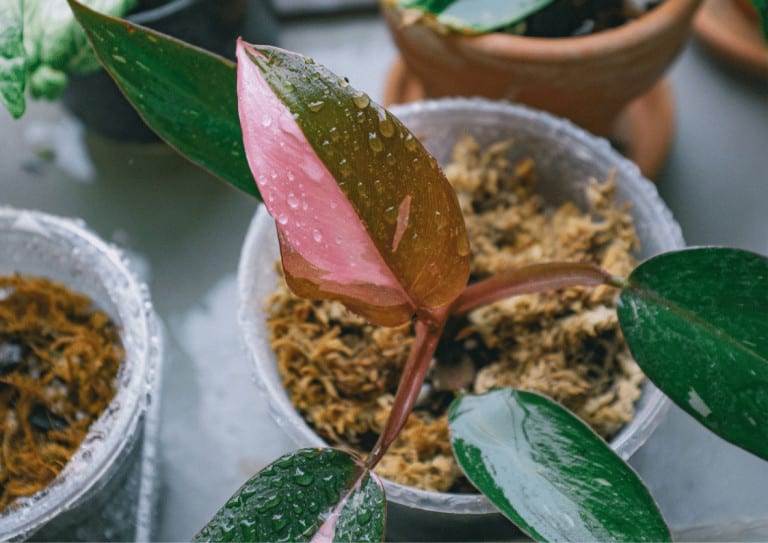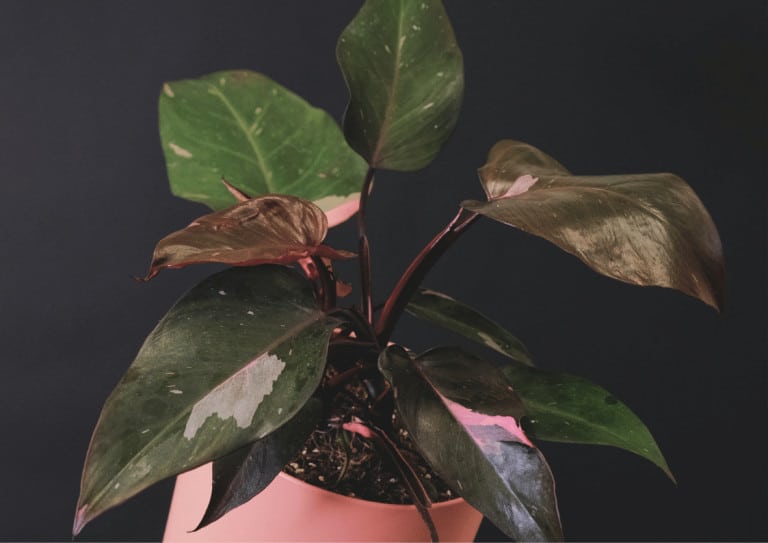Philodendron Pink Princess vs Pink Congo: What’s The Difference?
- Lakeisha Ethans
- April 22, 2022
If you buy something using the retail links in our articles, sometimes we earn a small affiliate commission. This does not impact the products we recommend.
Aesthetically pleasing plants have been all the rage in recent years. With so many trends and an increased interest in rare and unusual plants, variegated plants and plants of unique colors have risen notably in popularity. This has created a much bigger market of rare plants – and, as with any market with high demand, it’s lent itself to a few controversies.
The highly sought-after Philodendron Pink Princess is just one of the many much-loved rare plants in question. With large, variegated leaves speckled with pink, it’s very difficult to propagate with that lovely color and is accordingly priced. Also on the market is the Philodendron Pink Congo, which is similar in concept on paper but is actually very different!
There are several physical differences between the Pink Princess and the Pink Congo. But the biggest difference is that the Pink Princess is a man-made hybrid, selectively bred to produce natural pink variegated leaves. On the other hand, the Pink Congo is an artificial plant with chemically induced pink leaves that will eventually completely lose their color.
Knowing the difference between these two plants is important when you’re trying to purchase the correct Philodendron for your home. This article will give you some insight into this realm by the following questions:
- What is the Philodendron Pink Princess?
- What is the Pink Congo?
- What are the differences between the Philodendron Pink Princess and the Pink Congo?
- Is The Pink Congo a scam?
In this post, we’ll illustrate the differences between the Pink Princess and the Pink Congo and give you some information on the history of the latter.

What is the Philodendron Pink Princess?
The Philodendron Pink Princess is a man-made hybrid of the Philodendron plant. It is one of the several hundred species of this flora. It has been carefully bred for years to create a reliable pattern of genetic variegation. Variegation is a mutation where certain parts of a plant do not have chlorophyll, which is the component necessary for photosynthesis.
The Pink Princess boasts big, waxy leaves that rely on their green spots to continue to perform photosynthesis. This allows them to stay alive despite lacking the necessary chlorophyll in many places. Some of these plants have spotted pink leaves, but others have half-moon leaves that boast a bright pink color over half of the growth.
Some people may worry that the Pink Princess can revert to a fully green plant. While this is certainly possible, it’s also largely preventable. Pruning off green leaves and only leaving variegated growth will help to promote long-term, sustained variegation across all new leaves.
What is the Pink Congo?
The Pink Congo is a normal Philodendron Congo plant that has been treated to create artificial, pure pink leaves. This means that the plant is not an official cultivar and is entirely artificial. The Congo has large, oval leaves with smooth edges and typically grows as a vine. Newer hybrids have resulted in a single upright plant as opposed to vines.
The exact means of production of a Pink Congo is mostly unknown. There have been a few hints that a chemical is used to treat the plant. The chemical, after being absorbed, supposedly affects the chlorophyll production of the plant, leading to completely non-green leaves. The name and nature of the specific chemical is a closely-guarded secret by those in the know.
One of the most important features of the Pink Congo that you must know is that the pink color is not permanent. Once the chemical has been fully used up and the plant runs out of stores of it, it will revert to a completely green Philodendron Congo plant. The pink color slowly loses its intensity with each new pink leaf until it is no longer present.
This has been the subject of controversy because plant sellers have often chosen not to disclose the truth that these plants will lose their pinkness in just a few years.

What are the differences between the Philodendron Pink Princess and the Pink Congo?
There are some obvious physical differences between the Pink Princess and Pink Congo. For example, the Pink Congo has pointier leaves than the Pink Princess and often appears smoother in size and shape.
The leaves are the biggest difference, though. The Pink Princess usually has its pink color appear in patches, spots, and speckles, like a normal variegated plant. It’s almost unheard of for this plant to have a completely pink leaf. On the other hand, the Pink Congo has notably pure pink leaves that almost appear dipped in paint due to the concentration of the hue across entire leaves.
The most important distinction is the permanence of the pink on both plants. The Philodendron Pink Princess can keep its pink splotches for all of its life as long as it is carefully pruned to keep plain green leaves at bay.
Meanwhile, the Pink Congo’s pink leaves will last for anywhere from 6 months to 2 years only, eventually fading away back to green. There is nothing that can be done to prevent a Pink Congo’s reversion.

Is Pink Congo a scam?
The plant-lover community has long considered the Pink Congo a huge scam of large proportions. Large influencers and respected members of the community have rallied against its existence and the supposed scam received a lot of attention from national and international media. So, is the plant a complete scam?
It’s difficult to determine for sure if the Pink Congo’s original creation was ever intended as a scam, to begin with. However, it has certainly been used by certain shady sellers as a scam product. They market the plant as rare and genetically pink while leaving out the fact that the color will not last.
The Pink Congo is an artificially created plant and its pink color is not natural. Essentially, it’s a fake plant and it doesn’t exist in the natural world. But that’s never stopped people before! Many people, especially those who aren’t huge lovers of the plant community, buy fake or artificially made plants happily, and there are legal and ethical ways to market and sell them.
Problems and scams arise when sellers fail to disclose the fact that Pink Congos will revert to fully green leaves, or when they hide their disclaimers in very small fonts or among walls of text. Scam sellers also tend to keep the Pink Congos at a very high price while pushing them as highly rare plants to trick potential buyers.
But is the very existence of the Pink Congo intended as a scam? It’s hard to say. There are a lot of issues surrounding the information about the development of this plant. Chemicals like auxin, Strepson, and ethylene have been named as the products or items used to create the Pink Congo’s coloring.
But none of those chemicals have ever been proven to successfully block chlorophyll or produce any form of variegation or unusual coloring. This makes it difficult to verify any claims that Pink Congos were created solely to scam plant-lovers.
Regardless, you can avoid scams by staying aware of the differences between a Pink Congo and a Pink Princess. If you want a plant whose leaves can stay pink for the rest of its life, avoid Pink Congos completely.
Take home message
The Pink Princess is a manmade but genetically cultivated plant that continually produces beautiful variegated leaves with pink spots and patches. On the other hand, the Pink Congo is an artificially made plant with completely pink leaves that will fade into green over time.
Both of these plants have plenty of similarities, as they’re part of the Philodendron genus of plants. However, their differences are notable and should be taken into account when you’re choosing plants, especially given the controversial history of the Pink Congo.

Lakeisha Ethans
Houseplant Writer
Mother to two humans and hundreds of plant babies. Lakeisha uses her 15 years of experience as a content writer to specialise in simplifying what you need to know to grow and care for all indoor plants.
Similar Posts
Do Houseplants Help Boost Productivity?
From improved air-quality, to increased productivity at work, houseplants have the ability to improve our working days in multiple ways.
5 Of The Worst Indoor Plants For Allergies (Stop Your Sneezing!)
From resipiratory irritation to physical damage to your skin. It pays to be mindful of allergic reactions that some innocent looking houseplants can cause.



